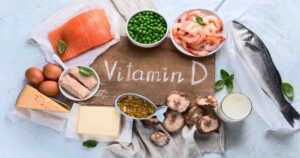
Vitamin D is a nutrient that the body needs in small quantities to function and stay healthy. It is also a fat soluble vitamin.
Vitamin D explained and uses of Vitamin D:
The vitamin has an essential role in the absorption and use of calcium and phosphorus, and therefore in the formation and health of bones, teeth, and cartilage ( the tough, fibrous tissue that covers the end of bones at joints ).
Vitamin D occurs in two forms: Vitamin D2 which is found in a small number of foods and Vitamin D3 which is formed in the skin when exposed to sunlight . Both D2 and D3 are converted into a form that the body can use ( active form ) in the liver and kidneys.
When calcium levels in the blood are low, parathyroid hormone is released by the parathyroid glands, which are located in the neck. This hormone stimulates the kidneys to convert Vitamin D into its active form, which in turn, stimulates the intestine to increase the absorption of calcium and phosphorus.
Vitamin D deficiency:
In countries where milk and dairy foods are enriched with vitamin D, deficiency is rare. Because sunlight is so important in the manufacture of Vitamin D, people most at risk are older adults, especially those who are bedridden or unable to go out and about.
Deficiency may also occur in people in very cold climates and those living in urban areas with high air pollution who get little exposure to sunlight, as they cover themselves completely.
Other groups at risk include those requiring long term use of certain anti – convulsant medications which interfere with the conversion of Vitamin D into its active form. In addition, people with chronic kidney disease (CKD), are at risk of a deficiency due to the kidneys inability to convert Vitamin D into its active form.
Symptoms of deficiency:
Deficiency of the vitamin is characterised by softening of the bones, a condition called osteomalacia in adults, and rickets in children. Osteomalacia may lead to pain in the legs, ribs, hips, and muscles, easily broken bones, and difficulty in climbing stairs or getting up from a sitting position. Rickets lead to deformity of the bones, especially bowing of the legs and abnormal curvature of the spine.
Other symptoms of Vitamin D deficiency can also include low immunity – like frequent illness or infections – ,fatigue and tiredness, impaired wound healing, depression, anxiety, hair loss and even weight gain.
Most adults should get 1500 to 2000 international units ( IU ) of Vitamin D daily.
Food sources of Vitamin D:
The best sources of Vitamin D are the flesh of fatty fish, such as mackerel, salmon, sardines and tuna. Fish liver oils like cod and halibut also contain Vitamin D. This is found naturally in all these foods, which contain atleast 3 mcg of the vitamin per 50 – 100 grams- 2 to 3 and a half ounces.
Smaller amounts are found in egg yolks, cheese and liver.
Certain other sources are milk, yogurt, fortified orange juice, almond milk, oatmeal, fortified milk, oysters, tofu, soya milk and oranges.
The next blog on Vitamins is on Vitamin A, the last fat soluble vitamin.
All the best and happy healing from Naturally Dimpi!

